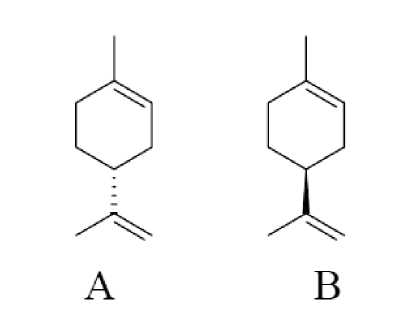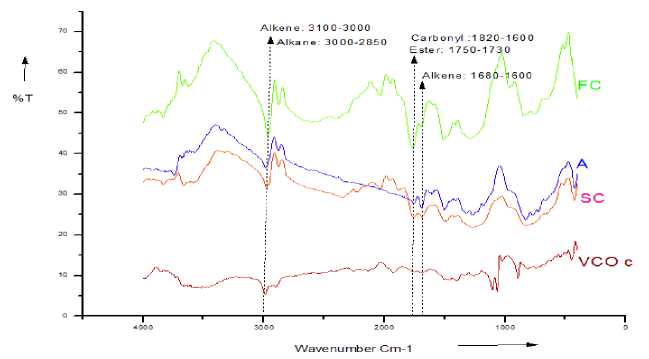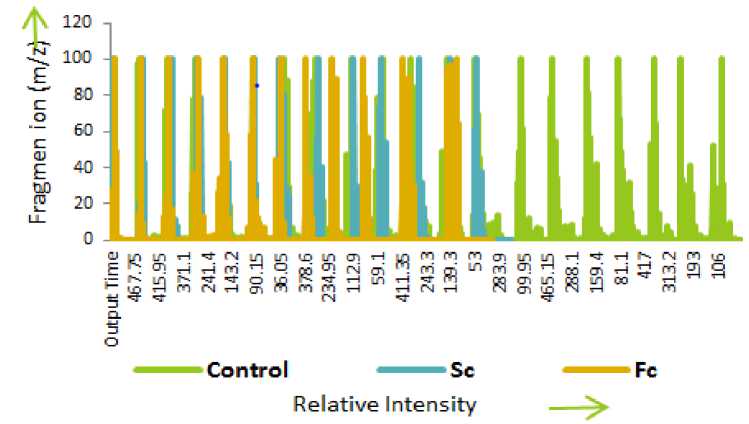ANALYSIS OF LIMONENE AND OTHER ANTIOXIDANTS IN COMMERCIALESSENTIAL OIL PRODUCTS COMPARED TO HOMEMADE VIRGIN COCONUT OIL
on
INTERNATIONAL JOURNAL OF BIOSCIENCES AND BIOTECHNOLOGY • Vol. 7 No. 1 • September 2019
eISSN: 2655-9994
pISSN: 2303-3371
https://doi.org/10.24843/IJBB.2019.v07.i01.p02
ANALYSIS OF LIMONENE AND OTHER ANTIOXIDANTS IN COMMERCIAL ESSENTIAL OIL PRODUCTS COMPARED TO HOMEMADE VIRGIN
COCONUT OIL
Ni Made Suaniti1*, I Wayan Bandem Adnyana2, Manuntun Manurung1, Oka Ratnayani1, and Raisyah Anjani1
1Chemistry Study Program, Mathematic and Natural Sciences Faculty, Udayana University, Bukit Jimbaran, Badung, Bali, Indonesia 80361
2Mechanical Engineering Study Program, Engineering Faculty, Udayana University, Bukit Jimbaran, Badung, Bali, Indonesia 80361
*Corresponding author: madesuaniti@unud.ac.id
ABSTRACT
Essential oil production in the market is very diverse with various brands labeled as antioxidants that have gained more attention in the society recently. The purpose of this study was to analyze limonene and other antioxidants content of the essential oils in the market compared to homemade virgin coconut oil. The method used was Gas Chromatography -Mass Spectrometry (GC-MS) and Fourier-transform infrared (FTIR) Spectroscopy. The infrared spectrogram showed the presence of alkanes and esters respectively at wave numbers of 3000-2850 and 1750-1730 cm-1. Chromatogram results showed the presence of limonene compounds and some antioxidants with a fairly good separation in the several types of oils, which was not detected in the homemade virgin coconut oil.
Keywords: antioxidants, limonene, product oil, virgin coconut oil
INTRODUCTION
Refresher oil with brand "Fresh" that has been used by the society recently continues to raise attention and developed more following the development of science and technology, which is also supported by the current availability of a variety of scents. Meanwhile, virgin coconut oil is also very potential and beneficial to be used as refresher oil.
Therefore, it is necessary to develop more attracted scents as well as conduct chemically qualitative and quantitative analysis for homemade virgin coconut oil
compared to the commercial product of essential oils. The qualitative analysis can be done by suspecting the functional groups by using infrared spectroscopy, and also the appearance of the compounds that can be determined by gas chromatography through retention time and mass spectrometry as ion fragments (m/z). The oil content in the essential oils which are volatile compounds, namely antioxidants, varies greatly both in the chemical structure and amount. The percentage of volatile compound such as limonene in the essential oils from plants is determined by GC-MS (Derwich et al., 2010;
Ibrahimi et al., 2013). Pinene compounds in the essential oils that are also detected in small amounts as volatile compounds through extraction methods (Tomasz et al., 2013). Active compounds in essential oils are also found qualitatively and quantitatively using GC-MS (Kaluzna-Czaplinska, 2007).
The quality of oil is very dependent on the method of preparation and analysis. The amount and variety of chemical compounds of oil from plants requires an easy and fast analysis effort such as GC-MS. This research was developed to analyze the limonene compounds and other antioxidants in the commercial essential oils product compared to homemade virgin coconut oil.
MATERIALS AND METHODS
The materials used were homemade virgin coconut oil, commercial essential oil products marked as Fc, F, A, P, and MA, ethanol pro analysis, and the equipments were volumetric flask, glass beaker, Fourier-transform infrared spectroscopy (FTIR) Prestige 21, and Gas Chromatography-Mass Spectrometry (GCMS) Shimadzu 210 Ultra.
FTIR method is one of the modern and simple qualitative analysis methods which use infrares radiation to change the vibration energy of a molecule or polyatomic ion. Vibration energy is determined by the strength of the bond and the mass of the molecule that can be characterized based on
the type of bond such as a single carbon alkane bond (C-C), a double/alkene bond (C=C), and a carbonyl bond (C=O). Carbonyl bonds are very sensitive, for example acids appear at wave number of 1650 cm-1, ketones at 1700 cm-1, esters at 1750 cm-1, and chloride at 1800 cm-1 (Harvey, 2000; Silverstein et al., 1991).
GC-MS is a modern method consisting of Gas Chromatography (GC) which interfaces with Mass Spectrometry (MS). The process starts with separation followed by identification of atomic mass per ion (m/z), so that GC-MS using detectors used as a qualitative analysis method is mass spectrometry. However, chromatography gas can also be combined with FTIR. The spectra information can often be used to identify liquid samples (Harvey, 2000). Furthermore GC-MS is widely used for the analysis of drug samples, food, and cosmetics spedifically for volatile compounds.
Identification of functional groups and atomic mass of essential oil or virgin coconut oil (VCO) samples can be analyzed by FTIR and GC-MS. VCO as an organic compound containing elements of carbon, hydrogen, and oxygen is subjected to infrared radiation which has a frequency (wave number of 500-4000 cm-1) that will be absorbed and then measured as percentage transmittance (%T). The compounds contained in VCO can also be separated by
gas chromatography and continue to be identified based on separate peaks as mass per ion by mass spectrometry.
RESULTS AND DISCUSSION
GC-MS analysis of compounds contained in fresh oils in the market marked with the codes Fc, Sc, A, P, and MA resulted in limonene compound with ion fragments
(m/z) of 68 and the alleged antioxidant compounds such as alpha pinene, delta 3 carene, beta pinene, and alpha phelandrene with m/z of 93 as shown in Table 1. The limonene (1,8-p-menthadiene = 1-methyl-4-(1- methylethenyl-cyclohexene) (Erasto and Viljoen, 2008) structure for example one of antioxidant in accordance with the literature as can be seen in Fig. 1.
Table 1. The presence of limonene and some antioxidants in fresh oil in GC-MS
Area x 1000000
|
Compounds |
Fc |
Sc |
A |
P |
MA |
|
Alpha pinene (m/z 93) |
n.d |
6.1 |
0 |
26.6 |
5.2 |
|
Delta-3-carene (m/z 93) |
n.d |
n.d |
0 |
1.1 |
n.d |
|
Beta pinene (m/z 93) |
6.7 |
12.4 |
15.1 |
2.7 |
n.d |
|
Alpha phelandrene (m/z 93) |
n.d |
0.8 |
n.d |
4.1 |
15.8 |
|
dl Limonene (m/z 68) |
n.d |
n.d |
46.9 |
6.1 |
9.7 |
n.d= no detection

Fig. 1. Structure of R-(+) limonene (A) and S-(–) limonene (B) (Erasto and Viljoen, 2008)
Similar function group detected using infrared spectrograms are shown as in Fig. 2, alleged alkanes, alkenes, and esters were detected. Alleged group alkanes were
indicated by sharp absorption at wave numbers 3000-2850 cm-1, alkenes at 16801600 cm-1 and carbonyl between 1820-1600 cm-1 supported by ester groups at 1750-1730
cm-1 very weak. The Fc sample had the strongest absorption and sharp band shape indicating the highest concentration of the compound content of the other two samples (A and Sc) as well as homemade virgin coconut oil.
Separation by gas chromatography followed by mass spectrometry produced fragment ions that can be seen in Fig. 3, which were the fragment ions (m/z) of commercial fresh oil samples (Sc and Fc) and
homemade virgin coconut oil as a control (VCOc).
Virgin coconut oil analyzed using FTIR showed that there were alkane and alkenes functional groups at wave numbers of around 3000 cm-1, carbony; (esters) at 1750 cm-1 and alkenes which strengthened in the region of 1680-1600 cm-1. Similar results were obtained for commercial essential products with stronger absorption as the marker of higher compound content.

Fig. 2. Spectogram of FTIR some Fresh oil (Fc, A, Sc) and VCO control (VCOc)

Fig. 3. Fragment ion of limonene and other antioxidant in commercial fresh oil (Sc and Fc) compared to homemade virgin coconut oil
Analysis of commercial samples by GC-MS showed the presence of compounds of alpha pinene, delta-3-carene, beta pinene, alpha pheladrene, and dl limonene, but these results varied and were not the same in all samples and not detected in the sample of homemade virgin coconut oil. However, Erasto and Viljoen (2008) found that limonene was one of the monoterpene hydrocarbon compounds in the essential oil of aromatic plants. In addition to hydrocarbons both in the form of single and double bonds it was also found carbonyl functional groups in varying amounts, and the concentration was higher for commercial products compared to homemade VCO.
GC-MS as a modern analysis method has been developed for qualitative analysis with retention time markers adjusted to the NISH and Willey libraries, then the percentage results obtained were used for further analysis quantitatively. Fragments ions between homemade and commercial were also different which indicated that the preparation of homemade one was pure without the addition of compounds that have antioxidant potential. The quality of virgin coconut oil differed depending on the selected method of preparation where the highest oil content was obtained by inducement method followed by heating and fermentation (Pontoh et al., 2008).
This is supported by literature and published research by Harvey (2000); Silverstein et al., 1991; Kaluszna-Czaplinska (2007); Derwich et al. (2010), Ibrahimi et al. (2013) and Tomasz et al. (2013).
CONCLUSIONS
Limonene and other antioxidants such as pinene, careen, and phelandrene obtained quite good separation while was not detected in the homemade VCO characterized by GC-MS. The analysis using FTIR of VCO and commercial essential oil products showed the presence of alkanes and esters functional groups at the wave numbers of 3000-2850 and 1750-1730 cm-1 respectively.
ACKNOWLEDGEMENT
This study supported by National Grant from Research, Technology and Higher Education Ministry of Indonesia 2019 and LPPM Udayana University with the contract No. 492.22/UN 14.4.A/LT/2019.
REFERENCES
Kaluzna J.-Czaplinska. (2007). GC-MS
Analysis of Biologically Active Compounds in Cosmopolitan Grasses. Acta Chromatographica 19, 279-282.
Pontoh J. Surbakti M. Br. Papilaya M. (2008). Kualitas Virgin Coconut Oil dari Beberapa Metode Pembuatan. Chemistry Progress. 1, (1), 60-65.
Derwich E. Benziane Z. Taouil R. (2010).
GC/MS Analysis of Volatile
Compounds of the Essential Oil of the Leaves of Mentha pulegium growing in Morocco. Chemical Bulletin of “Politehnica” University of
Timisoara, Romania. 55,(69), 103
106.
Ibrahimi M. H. Papajani V. Cavar S. Matevski V. (2013). GC/MS Analysis of the Essential Oil of Thymus Longicaulis Presl. From Kosovo.
Bulletin of the Chemists and
Technologists of Bosnia and
Herzegovina 41, 6-10.
Tomasz BAJ. Ludwiczuk A. Seineawska E. Skalicka-Wozniak K. Widelski J. Sieba K. Gloniak K. 2013. GC-MS Analysis of Essential Oils from Salvia Officinalis L. Comparison of Extraction Methods of The Volatile components. Acta Poloniae
Pharmaceutica-Drug Research. 70, (1), 35-40.
Harvey D. (2000). Modern Analytical Chemistry. 1st ed. McGraw-
HillHigher Education. Singapore, Toronto. Ch. 10. pp. 446.
Silverstein RM, Bassler, G.C., and Morrill, T.C. (1991). Spectrometric
Identification of Organic Compounds. 5th Ed. Wiley. Ch. 2. pp. 3-16.
Erasto P. and Viljoen AM. (2008). Limonene- A Review: Biosynthetic, Ecological and Pharmacological Relevance. Natural Product
Comunications. 3, (7), 1193-1202.
FACULTY OF AGRICULTURE, UDAYANA UNIVERSITY • 17
Discussion and feedback